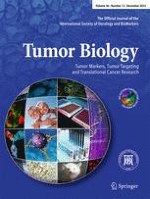Published in:

01-12-2015 | Research Article
RETRACTED ARTICLE: Interaction between TNFR1 and TNFR2 dominates the clinicopathologic features of human hypopharyneal carcinoma
Authors:
Xiuru Ma, Xiaoming Li, Xiuying Lu, Lifeng Jia, Hui Li, Qi Song
Published in:
Tumor Biology
|
Issue 12/2015
Login to get access
Abstract
Although the expression of tumor necrosis factor receptors (TNFRs) has been associated with clinicopathologic features of some other cancers, their roles in hypopharyngeal squamous cell carcinoma (HPSCC) have not been documented. Forty-five HPSCC specimens were analyzed for the expression of TNFR1 and TNFR2 and its relationship with clinicopathologic factors. Interaction between the two receptors and its effects on TNF-α was investigated by neutralizing TNFR1 and upregulation of TNFR2. The results indicated that, in HPSCC specimens, the expression of TNFR1 but not TNFR2 is associated with clinical staging, T stage, cervical lymph node metastasis, and histologic grade in HPSCC. In Fadu cells, when conjugating with its receptors, TNF-α mediates proliferation effects, and neutralizing TNFR1 and/or upregulating TNFR2 evokes proliferation-inhibiting and apoptosis-inducing effects and potentiates cisplatin (DDP)-induced growth inhibition and apoptosis induction. In conclusion, interaction of TNFR1 with TNFR2 determines the biological characters of HPSCC, and TNFR1 may dominate this process. Moreover, interaction between the two receptors plays important roles in determining the fates of HPSCC cells and thus may serve as a therapeutic target for developing new therapeutic strategies for HPSCC.